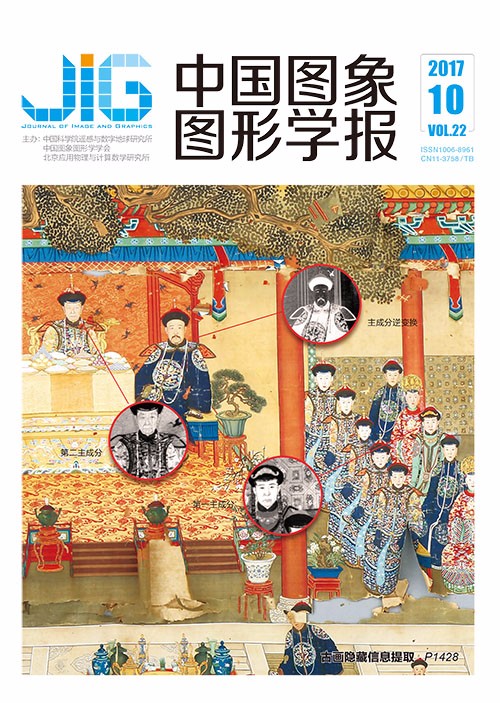
结构识别引导下的纹理抑制图像平滑
摘 要
目的 针对目前已有的纹理平滑方法难以在抑制强梯度和尺度变化纹理的同时保持完整结构的问题,提出一种结构识别引导下的纹理抑制图像平滑算法。方法 首先,结构与纹理的根本区别在于重复模式,结构应该是稀疏的,而纹理应该是一个有重复模式的区域,因此,通过对结构/纹理的多尺度分析,提取了对于结构/纹理具有辨别力的多尺度内变差特征;然后,借助支持向量机,对提取的特征样本点训练出一个结构/纹理分类器;就分类结果中存在的结构较粗、毛刺等问题,进一步对分类结果进行细化和剔除毛刺与孤立点的后处理操作,以获得最终的更为精细的结构识别结果;最后,提出结构引导下的自适应双边图像滤波算法,达到既能抑制强梯度和尺度变化的纹理又能保持结构完整性的图像平滑效果。结果 本文提出的多尺度内变差特征在支持向量机训练中达到了96.12%的正确率,结构引导下的图像滤波能够在保持结构的同时,有效地抑制强梯度和尺度变化的纹理细节。结论 本文算法在兼顾结构的保持和强梯度以及尺度变化纹理的抑制方面超越了已有的方法,对于结构提取、细节增强、图像分割、色调映射、图像融合和目标识别等众多技术领域的发展将具有较强的促进作用,体现了潜在的实际应用价值。
关键词
Structure recognition guided texture suppressing image smoothing
Shao Huan1, Fu Xinyi2, Liu Chunxiao1, Wu Min1, Gong Chen1, Yu Zongjie1(1.School of Computer Science & Information Engineering, Zhejiang Gongshang University, Hangzhou 310018, China;2.School of Management and E-Business, Zhejiang Gongshang University, Hangzhou 310018, China) Abstract
Objective Natural scenes generally contain different scale objects and textures,which carry rich information in regard to human perception.Texture usually signifies pixel values,which change with high frequency.Generally,images are composed of many important structures,texture,edges,etc.Therefore,mining the meaningful structure from textures or complex background images is a critical task in vision processing.The core of image smoothing lies in the separation of structure and texture.Effective preservation of the structure while suppressing the texture with strong gradient or varying scales is a challenging problem.Most of the existing image smoothing methods tends to deal with weak gradient texture images;if the texture gradient is strong,then these methods will fail.To solve the abovementioned problem,a structure recognition guided texture smoothing algorithm is proposed,which deals with the structure and the texture separately and detect structure before image smoothing.Method First,this paper argues that the fundamental difference between structure and texture is the repetition pattern.Particularly,the structure should be sparse and the texture should be a region with a repeating pattern.According to this characteristic,the discriminative features for distinguishing between structure and texture are designed and extracted based on the multi-scale analysis of inherent variation.At least two reasons are available for presenting the multi-scale approach.One reason is that structure and texture are relative.When the scale is small,the texture may not show up,and thus the scale needs to be enlarged and the essence of the texture is released.The other reason is that the texture in the image is diverse,and the adaptive scale in different regions is difficult.Furthermore,textures with various attributes may exist in the same image,a single scale can only solve the partial texture with the default scale parameter and the recognition of other textures will lose.Therefore,multi-scale analysis of inherent variation is proposed to ensure that different textures can display their own repetitive pattern attributes.Second,the core part in the field of pattern recognition is feature extraction.Therefore,the feature extracted must be more robust to guarantee the discrimination ability is strong enough and the stability is good enough.To obtain more accurate features,we need to consider the multi-scale inherent variation in the macroscopic view and grasp its general rules.After we analyze the trend of multi-scale inherent variation curves at different pixel locations,several discriminative features are extracted.Then,these features can be used for subsequent structural recognition.We regard the separation of texture and structure as a typical two-class issue,and the support vector machine is a classical two-class classification method.Compared with many existent machine learning methods,it is a relatively lightweight classifier,which can obtain desirable classification results without a large sample.Consequently,this paper prefers to use the support vector machine to distinguish the texture and structure,with the help of support vector machine,a classifier is trained with the extracted feature pixels,and utilized to classify structure and non-structure pixels efficiently.However,due to the block effect in edge compression and the computational mechanism of inherent variation,pixels nearby the structure will always be affected by the real structure and its multi-scale inherent variation curve is similar in structure.Hence,the support vector machine classification results cannot reach a single pixel.We observed large amounts of data and find that the non-structured pixel appeared symmetrically on both sides of the window.Although the support vector machine classification results are coarser,in the middle of the skeleton should be considered as the real structure.In this paper,a morphological thinning method is adopted directly to get a thinner structure,but the results of thinning still have some weakness.To dispose the shortcomings of the support vector machine classification results after thinning operation,we design two steps of post-processing work,including outlier rejection and deburring,which solve the burr and mistaken isolate.As such,the finer structure recognition maps can be obtained.Finally,based on the fine structure obtained in the previous step,a structure guided bilateral image smoothing method is put forward to remove texture while preserving structure.Result The multi-scale inherent variation features proposed in this paper achieve a correct rate of 96.12% with support vector machine,and our structure guided image smoothing results can effectively suppress the texture details with strong gradient or varying scales while preserving the structure.These excellent experimental results are compared to some results of previous methods,which reveal that the proposed methodology yields better image smoothing.Conclusion In view of the limitations of existing similar methods,this paper analyzes the characteristics of inherent variation deeply and proposes an algorithm to distinguish the structure and texture by means of multi-scale inherent variations.Based on the support vector machine classification results,a post-processing is used to obtain a finer structure recognition map.Then,a structure guided bilateral image smoothing method is applied to remove texture while preserving structure.Our algorithm outperforms the state-of-the-art image smoothing methods,especially for those images containing texture with strong gradient or varying scales,which could strongly promote such technical fields as structure extraction,detail enhancement,image segmentation,tone mapping,image fusion,and object recognition,which reflect the potential practical application values.
Keywords
texture suppressing structure recognition multi-scale inherent variation strong texture varying scales
|



 中国图象图形学报 │ 京ICP备05080539号-4 │ 本系统由
中国图象图形学报 │ 京ICP备05080539号-4 │ 本系统由